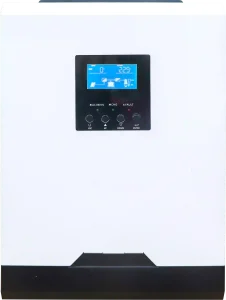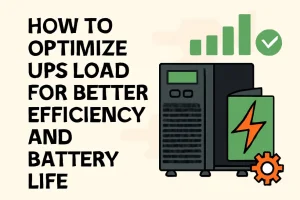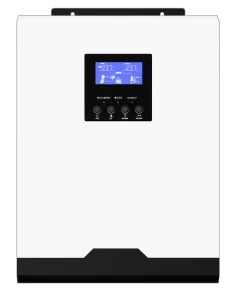Most businesses and factories in emerging markets treat their UPS like a full-time inverter. When the grid drops for hours every day, the UPS becomes the only thing keeping the lights on, the servers running, and the production line moving. That reality forces one big question: how much load can you really hang on a UPS without killing it in a year or two?
SOROTEC has been building power solutions in Shenzhen since 2006, and the On & Grid MPGS Series 50-600kW is exactly the kind of machine that now carries entire workshops, cold rooms, and office blocks across Africa, the Middle East, and Southeast Asia when the public supply disappears. These units were designed from the ground up for customers who have no choice but to run heavy loads for long stretches.

What Is the Ideal Load Percentage for UPS Operation?
Ask any SOROTEC field engineer in Lagos or Karachi and they will give you the same rule of thumb: keep daily running load between 50% and 80% of rated capacity. Push past 80% for weeks on end and trouble shows up fast.
Optimal 50-80% Range for Longevity
Inside that sweet spot the batteries stay cooler, the fans don’t scream all day, and charge-discharge cycles are gentler. A 200 kW MPGS running at 140 kW continuous will easily hit the promised 10-year battery design life. Drop to 100 kW and the same system often lasts 12-14 years in real-world conditions.
Efficiency Gains at Moderate Loads
The inverter itself runs happier too. Peak efficiency on the MPGS series sits right around 70% load. Stay there and you waste less power as heat, which matters when diesel prices are high and every kilowatt counts.
Risks of Exceeding 80% Capacity
Cross into 90-100% territory day after day and the story changes. Battery temperature climbs, electrolyte dries out faster in lead-acid banks, and lithium cells age quicker than anyone expects. One textile mill in Faisalabad learned this the hard way: they loaded a 300 kW unit to 290 kW for six months straight. Battery bank failed at month nineteen instead of the expected eight years. Exactly how load shortens battery life and drops efficiency is explained in detail here: How UPS Load Affects Battery Life and Efficiency
Can You Safely Use a UPS as an Inverter?
Yes—provided the UPS was built for the job. Many small office UPS units were never meant to run fans and fridges for eight hours. The MPGS series, on the other hand, was drawn up for exactly that life.
Seamless Switching in SOROTEC MPGS Models
Transfer time sits below 10 ms, fast enough that computers and PLCs never notice the grid is gone. That matters when the same UPS has to act like an inverter for half the day.
Handling Inverter Loads Under 600 kW
A single MPGS cabinet goes up to 600 kW, and you can parallel as many as needed. Factories commonly run induction motors, chillers, and welding machines straight off these boxes without drama.
Built-in Protections for Inverter Mode
Over-current, over-temperature, and deep-discharge cutoffs are all standard. The moment load tries to pull more than the system can give, the MPGS simply bypasses to whatever grid or generator is available instead of letting itself cook.
How Does Overloading Affect UPS Reliability?
Everyone has seen the smoking UPS story on WhatsApp groups. Overloading is usually the villain.
Reduced Battery Life from Excess Strain
Heat is the real killer. Every 10 °C rise above 25 °C cuts lead-acid life in half. Run a battery room at 40 °C because the UPS is always at 100% load and you’re looking at replacements every 18-24 months instead of 8-10 years.
Heat Buildup and Component Failure
Fans pull harder, IGBT modules run hotter, capacitors dry out. One cold-storage customer in Ghana replaced three 500 kVA units in four years until they finally dropped continuous load from 480 kW to 380 kW. Same units are still running fine six years later.
Emergency Shutdown Triggers in MPGS Series
The good news: MPGS won’t let you destroy it without warning. Red alarms, SMS alerts through the built-in GPRS card, and automatic load-shedding relays all kick in before real damage happens.

What Factors Influence Safe UPS Loading?
Load planning is not just about adding up nameplates.
Power Demands of Connected Devices
Start motors on pumps and air compressors can pull 5-7 times running current for a few seconds. The MPGS handles that surge without blinking, but you still have to count it when you size the system.
Environmental Conditions and Ventilation
A unit sitting in direct sun on a rooftop in Dubai needs more headroom than the same box inside an air-conditioned data center in Johannesburg. SOROTEC rates the MPGS for 40 °C ambient, but keeping it under 35 °C pays back in years of extra life.
Integration with Solar Inputs via MPPT
Many customers now tie rooftop solar into the DC bus of the MPGS. That drops the effective AC load during daylight hours and lets the same UPS run closer to full capacity without stressing batteries at night.
Why Choose SOROTEC MPGS for Optimal Daily Use?
Customers who live on UPS power every day pick the MPGS for three practical reasons.
<10 ms UPS Switching for Uninterrupted Power
Lights don’t even flicker. That alone keeps production managers happy.
Peak-Valley Charging for Cost Savings
Set the MPGS to charge batteries only when grid power is cheap at night, then run everything off battery through expensive peak hours. Factories in Pakistan routinely cut their monthly bill by 25-30% doing exactly that.
Scalable 50-600 kW Capacity for Commercial Needs
Start with one 200 kW module today. Add another two years down the road when the factory expands. No need to replace the whole system—just slide in another cabinet and flip a few breakers.
Conclusion: Balancing Load for Maximum UPS Performance
Treat your UPS like a long-distance truck, not a sprint car. Keep daily load between 50% and 80%, give it decent airflow, and don’t ignore the alarms. Do that and a SOROTEC MPGS will quietly carry your business through years of unreliable grid power without expensive surprises.
Need help figuring out the right size or load plan for your own facility? The SOROTEC team has sized hundreds of these systems across emerging markets and can run the numbers for you in a single afternoon.
FAQ
Q1: Can the MPGS series really replace a traditional inverter for 8-10 hours daily?
A: Yes. The whole platform was designed for customers who face long daily outages. Battery sizing and cooling systems are built for continuous inverter duty, not just a few minutes of emergency runtime.
Q2: What happens if load suddenly jumps above rated capacity?
A: The MPGS instantly switches non-critical loads to bypass (if grid or generator is available) or sheds selectable loads through built-in contactors. Critical equipment stays online; the system refuses to damage itself.
Q3: Is it okay to run the MPGS at 30-40% load all day?
A: Perfectly fine. Efficiency drops a little below 50% load, but component wear is minimal and battery life actually gets longer. Many customers deliberately oversize for future growth and run light loads for years with no issues.








